4D FinalAssignmentSBP Team4D (1) (PDF)
File information
Title: Microsoft Word - 4D - FinalAssignmentSBP - Team4D.doc
This PDF 1.3 document has been generated by Word / Mac OS X 10.10.5 Quartz PDFContext, and has been sent on pdf-archive.com on 03/10/2016 at 15:09, from IP address 145.90.x.x.
The current document download page has been viewed 434 times.
File size: 6.09 MB (79 pages).
Privacy: public file
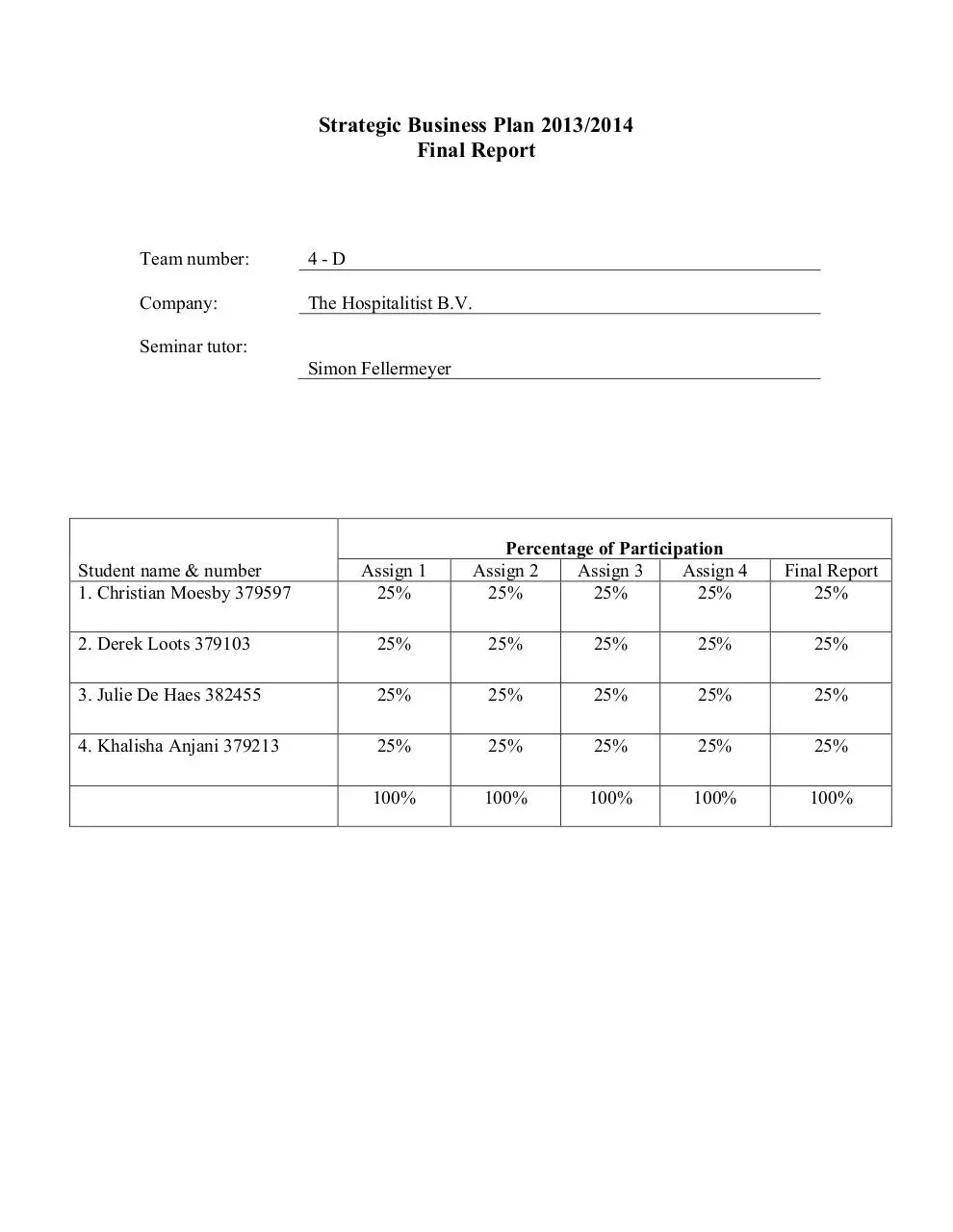
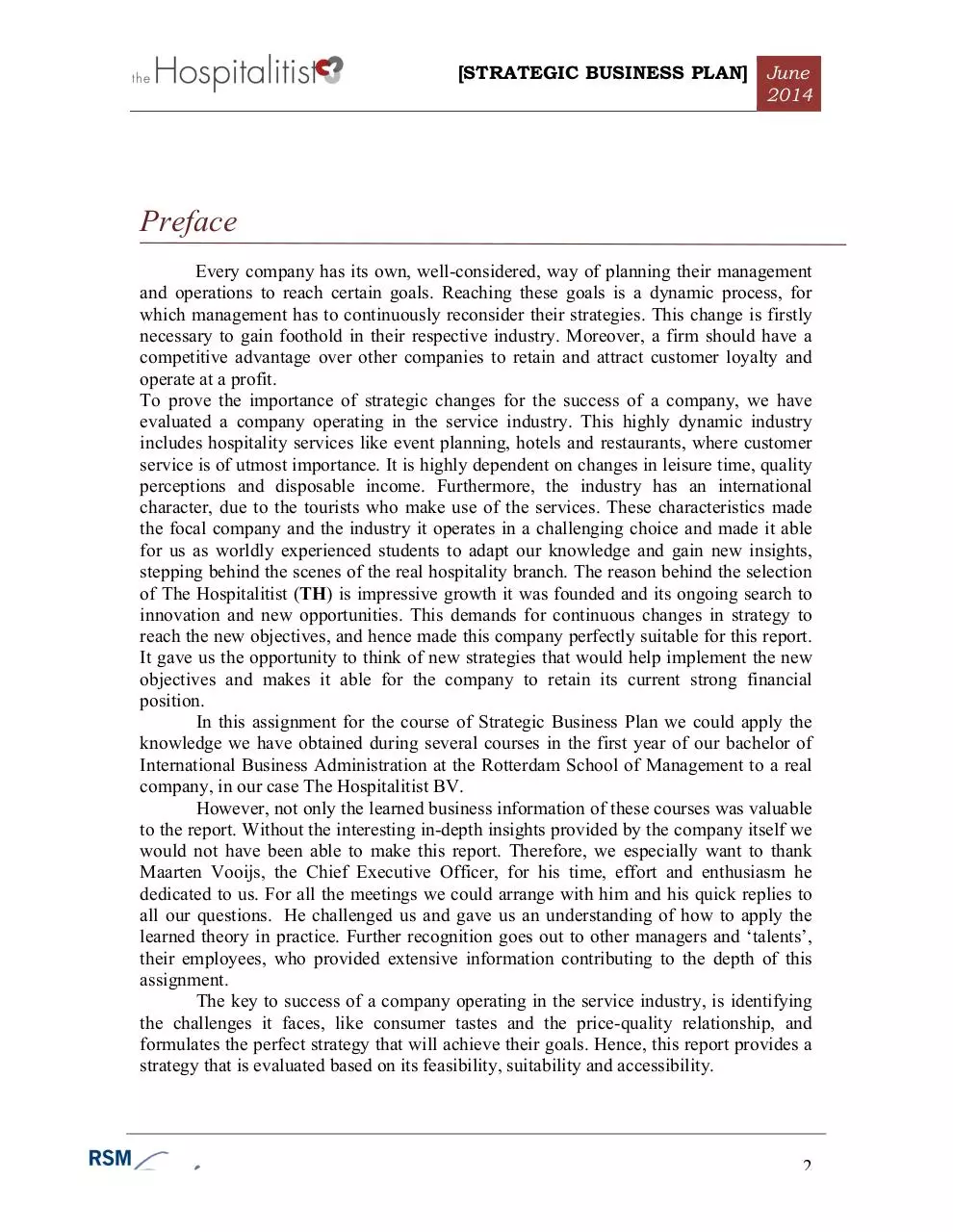
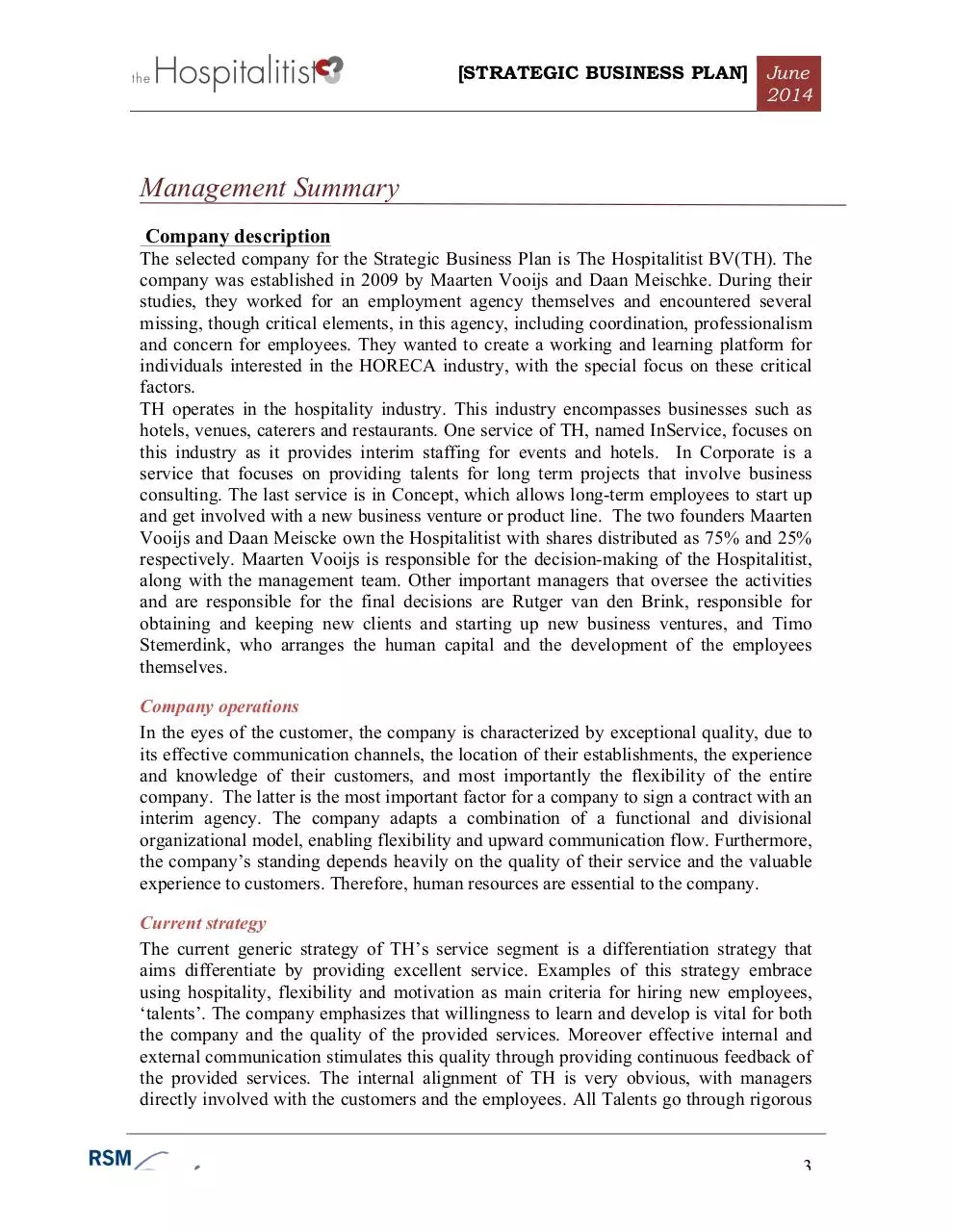

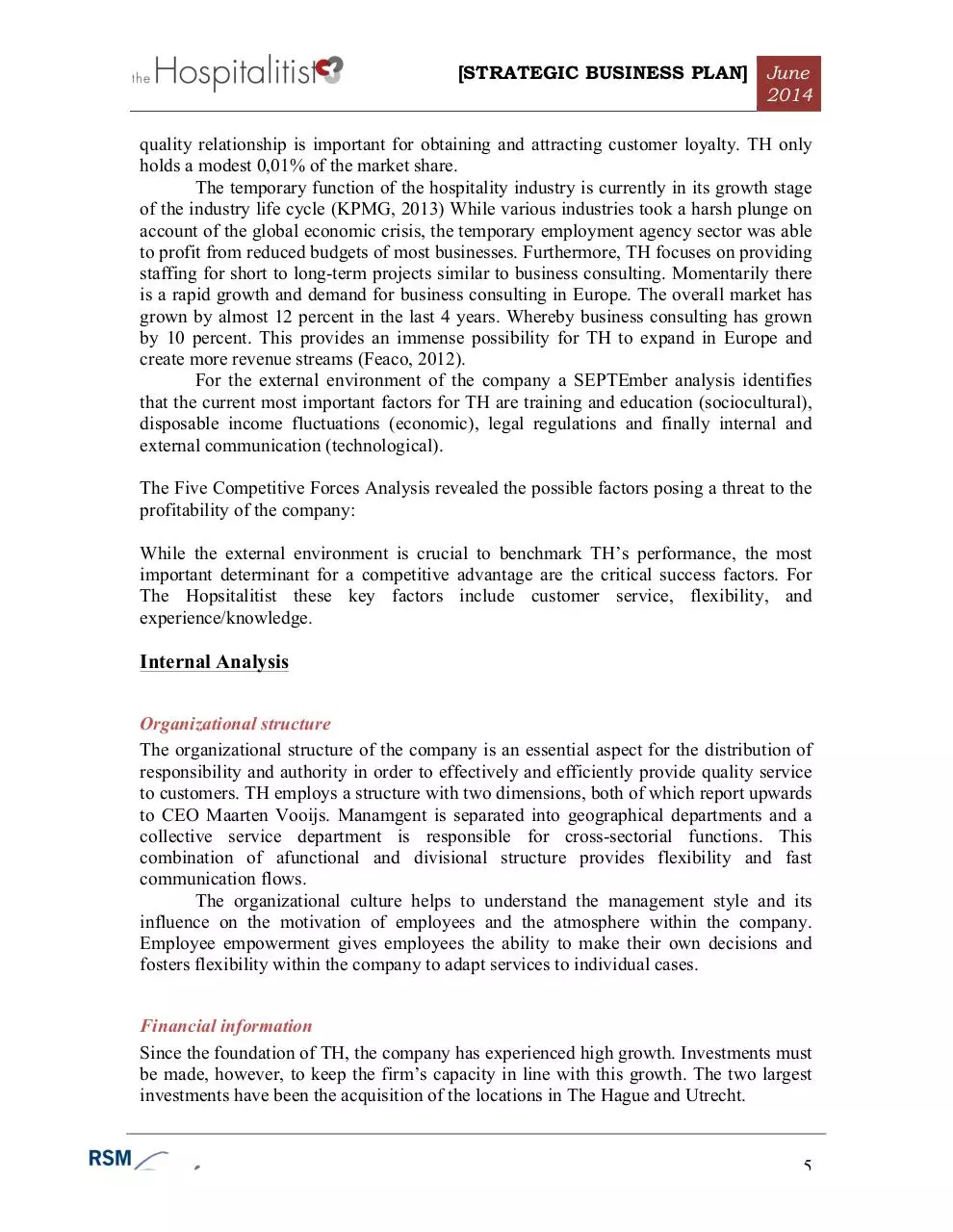
File preview
Strategic Business Plan 2013/2014
Final Report
Team number:
4-D
Company:
The Hospitalitist B.V.
Seminar tutor:
Simon Fellermeyer
Student name & number
1. Christian Moesby 379597
Assign 1
25%
Percentage of Participation
Assign 2
Assign 3
Assign 4
25%
25%
25%
Final Report
25%
2. Derek Loots 379103
25%
25%
25%
25%
25%
3. Julie De Haes 382455
25%
25%
25%
25%
25%
4. Khalisha Anjani 379213
25%
25%
25%
25%
25%
100%
100%
100%
100%
100%
[STRATEGIC BUSINESS PLAN] June
2014
Preface
Every company has its own, well-considered, way of planning their management
and operations to reach certain goals. Reaching these goals is a dynamic process, for
which management has to continuously reconsider their strategies. This change is firstly
necessary to gain foothold in their respective industry. Moreover, a firm should have a
competitive advantage over other companies to retain and attract customer loyalty and
operate at a profit.
To prove the importance of strategic changes for the success of a company, we have
evaluated a company operating in the service industry. This highly dynamic industry
includes hospitality services like event planning, hotels and restaurants, where customer
service is of utmost importance. It is highly dependent on changes in leisure time, quality
perceptions and disposable income. Furthermore, the industry has an international
character, due to the tourists who make use of the services. These characteristics made
the focal company and the industry it operates in a challenging choice and made it able
for us as worldly experienced students to adapt our knowledge and gain new insights,
stepping behind the scenes of the real hospitality branch. The reason behind the selection
of The Hospitalitist (TH) is impressive growth it was founded and its ongoing search to
innovation and new opportunities. This demands for continuous changes in strategy to
reach the new objectives, and hence made this company perfectly suitable for this report.
It gave us the opportunity to think of new strategies that would help implement the new
objectives and makes it able for the company to retain its current strong financial
position.
In this assignment for the course of Strategic Business Plan we could apply the
knowledge we have obtained during several courses in the first year of our bachelor of
International Business Administration at the Rotterdam School of Management to a real
company, in our case The Hospitalitist BV.
However, not only the learned business information of these courses was valuable
to the report. Without the interesting in-depth insights provided by the company itself we
would not have been able to make this report. Therefore, we especially want to thank
Maarten Vooijs, the Chief Executive Officer, for his time, effort and enthusiasm he
dedicated to us. For all the meetings we could arrange with him and his quick replies to
all our questions. He challenged us and gave us an understanding of how to apply the
learned theory in practice. Further recognition goes out to other managers and ‘talents’,
their employees, who provided extensive information contributing to the depth of this
assignment.
The key to success of a company operating in the service industry, is identifying
the challenges it faces, like consumer tastes and the price-quality relationship, and
formulates the perfect strategy that will achieve their goals. Hence, this report provides a
strategy that is evaluated based on its feasibility, suitability and accessibility.
2
[STRATEGIC BUSINESS PLAN] June
2014
Management Summary
Company description
The selected company for the Strategic Business Plan is The Hospitalitist BV(TH). The
company was established in 2009 by Maarten Vooijs and Daan Meischke. During their
studies, they worked for an employment agency themselves and encountered several
missing, though critical elements, in this agency, including coordination, professionalism
and concern for employees. They wanted to create a working and learning platform for
individuals interested in the HORECA industry, with the special focus on these critical
factors.
TH operates in the hospitality industry. This industry encompasses businesses such as
hotels, venues, caterers and restaurants. One service of TH, named InService, focuses on
this industry as it provides interim staffing for events and hotels. In Corporate is a
service that focuses on providing talents for long term projects that involve business
consulting. The last service is in Concept, which allows long-term employees to start up
and get involved with a new business venture or product line. The two founders Maarten
Vooijs and Daan Meiscke own the Hospitalitist with shares distributed as 75% and 25%
respectively. Maarten Vooijs is responsible for the decision-making of the Hospitalitist,
along with the management team. Other important managers that oversee the activities
and are responsible for the final decisions are Rutger van den Brink, responsible for
obtaining and keeping new clients and starting up new business ventures, and Timo
Stemerdink, who arranges the human capital and the development of the employees
themselves.
Company operations
In the eyes of the customer, the company is characterized by exceptional quality, due to
its effective communication channels, the location of their establishments, the experience
and knowledge of their customers, and most importantly the flexibility of the entire
company. The latter is the most important factor for a company to sign a contract with an
interim agency. The company adapts a combination of a functional and divisional
organizational model, enabling flexibility and upward communication flow. Furthermore,
the company’s standing depends heavily on the quality of their service and the valuable
experience to customers. Therefore, human resources are essential to the company.
Current strategy
The current generic strategy of TH’s service segment is a differentiation strategy that
aims differentiate by providing excellent service. Examples of this strategy embrace
using hospitality, flexibility and motivation as main criteria for hiring new employees,
‘talents’. The company emphasizes that willingness to learn and develop is vital for both
the company and the quality of the provided services. Moreover effective internal and
external communication stimulates this quality through providing continuous feedback of
the provided services. The internal alignment of TH is very obvious, with managers
directly involved with the customers and the employees. All Talents go through rigorous
3
[STRATEGIC BUSINESS PLAN] June
2014
training and need to obtain a certain amount of credits each year by doing workshops at
TH. This differentiation strategy is also reflected in price, with a well-considered tradeoff
between price and quality by the customers. Hence, the value proposition can be stated
as: ‘Providing the best quality of service at a reasonable price, while providing a platform
of learning and development for their employees to optimize their potential’. For this
reason, one important strategic objective of the company is to improve the quality of the
service. Whilst the business model is not yet fully developed and the company is
currently growing rapidly, this is its main focus. Another goal is to increase profit
margins by at least 10% by 2015. International expansion is another objective, which
would be possible when the company has a clear defined transferable business model. For
this reason, this is a long-term objective. The last objective is a shift in focus to the In
Corporate segment of the business. This would respond to the high demand in the
business consultancy market and in turn result in higher profit margins.
The mission statement gives a valuable guideline to the company and all
employees, while giving a clear direction to the strategic objectives. The mission
statement is, shortly, ‘ The flexibility of the talents is paramount to the quality of the
service. The company should become as innovative as possible to optimize the
development and potential of the prized talents’ (Vooijs, 2012). Surrounded by a
supportive environment and with a focus on brand loyalty, the company gains a
competitive advantage.
External analysis
We defined the market where TH operates in as an employment agency in the Hospitality
branch. The entire interim employment industry in the Netherlandsi consist of a total of
3260 employment agencies generating a total revenue of 9,9 billion euros. The priceThreat of new entrants
!
!
!
Low capital requirements in terms of start-up costs and low wages
Experience and knowledge are important to build trust with clients
Threat: moderate
Bargaining power of
suppliers
!
!
!
!
Many different suppliers because every worker is potentially supplying him/her self
Multiple potential industries for employment exist, and suppliers can move around between these, depending on
how binding the contract is
Attractiveness depends on incentives like advancement or progression plans for employees
Threat: low to moderate
Bargaining power of
buyers
!
!
!
!
Amount of buyers is constantly rising due to the shift towards part-time labor in most service industries
Rising unemployment gives more choice and bargaining power to market buyers
Potential for vertical integration of labor development processes
Threat: moderate to high
Threat of substitutes
!
!
!
Only threat of alternate means of employment, such as full time employment or outsourcing
Higher total costs of training, employee benefits and management and less flexibility
Threat: low
Competitive rivalry
!
High market segmentation and specialization by variables such as geographical location, price/quality, and
venue specialization
Low capital requirements and weak exit barriers
Threat: low
!
!
4
[STRATEGIC BUSINESS PLAN] June
2014
quality relationship is important for obtaining and attracting customer loyalty. TH only
holds a modest 0,01% of the market share.
The temporary function of the hospitality industry is currently in its growth stage
of the industry life cycle (KPMG, 2013) While various industries took a harsh plunge on
account of the global economic crisis, the temporary employment agency sector was able
to profit from reduced budgets of most businesses. Furthermore, TH focuses on providing
staffing for short to long-term projects similar to business consulting. Momentarily there
is a rapid growth and demand for business consulting in Europe. The overall market has
grown by almost 12 percent in the last 4 years. Whereby business consulting has grown
by 10 percent. This provides an immense possibility for TH to expand in Europe and
create more revenue streams (Feaco, 2012).
For the external environment of the company a SEPTEmber analysis identifies
that the current most important factors for TH are training and education (sociocultural),
disposable income fluctuations (economic), legal regulations and finally internal and
external communication (technological).
The Five Competitive Forces Analysis revealed the possible factors posing a threat to the
profitability of the company:
While the external environment is crucial to benchmark TH’s performance, the most
important determinant for a competitive advantage are the critical success factors. For
The Hopsitalitist these key factors include customer service, flexibility, and
experience/knowledge.
Internal Analysis
Organizational structure
The organizational structure of the company is an essential aspect for the distribution of
responsibility and authority in order to effectively and efficiently provide quality service
to customers. TH employs a structure with two dimensions, both of which report upwards
to CEO Maarten Vooijs. Manamgent is separated into geographical departments and a
collective service department is responsible for cross-sectorial functions. This
combination of afunctional and divisional structure provides flexibility and fast
communication flows.
The organizational culture helps to understand the management style and its
influence on the motivation of employees and the atmosphere within the company.
Employee empowerment gives employees the ability to make their own decisions and
fosters flexibility within the company to adapt services to individual cases.
Financial information
Since the foundation of TH, the company has experienced high growth. Investments must
be made, however, to keep the firm’s capacity in line with this growth. The two largest
investments have been the acquisition of the locations in The Hague and Utrecht.
5
[STRATEGIC BUSINESS PLAN] June
2014
The following shortened version of the balance sheet of TH is as of December 30th, 2012.
Financial ratios
The Solvability ratio of the company lies perfectly in between 1 and 2 with a ratio of
1.73, which means it is capable of paying of its long-term debt. The Current ratio is 1.41,
which is also implies that the capital structure is sufficiently liquid. And the quick ratio is
the same as the current ratio because TH holds no inventory it is a service. The return on
sales ratio is 0.066 meaning for every 1 euro in revenue 6.6 cents go to the firm’s profits
this means that TH is working on good margins. The return on equity ratio is 0.44, which
is extremely high for the industry. This means that the firm is highly profitable and a
good investment for potential investors. The final financial ratio is return on investment,
which is 0.19 meaning they are using the resources efficiently. Overall The Hospitalities
has a stable financial structure.
Performance in functional areas
The four most important functions that are carried out by TH are marketing, accounting,
operations and human resource management. The company scores high on its most
important functions, namely operations and HRM. Both areas foster the training and
development of the employees and the quality of the service itself. Despite a low score in
accounting, the financial results of TH demonstrate overall cohesion and functionality.
As the firm continues to grow, however, it will be essential to monitor weaker functions,
and prevent them from stumping growth.
6
[STRATEGIC BUSINESS PLAN] June
2014
Confrontation and overview of strategic options
The following SWOT analysis emphasizes the company’s strengths, weaknesses,
opportunities and threats. The important relationships are highlighted with an X. This
analysis allows us to assess how to endeavor the opportunities the company has and how
to combat the threats that it may have to face. Additionally, it enables us to conceptualize
possible strategies for TH.
Selection of strategy and implementation plan
After evaluating the dynamics and internal and external environments, we have chosen a
new strategy based on its feasibility, suitability and acceptability. The following new
objectives will emerge:
1. Expanding percentage of turnover derived from In Corporate
2. Increased investment in in Corportae to facilitate data mining activities
3. Further development of organizational structure to accommodate changed focus
4. Become competitive
Together with the lower-level goals, this set of objectives will make up the strategic
goals.
Changes in resources
To accomplish the new strategic goals, new resources will have to be acquired.
Regarding physical resources, investment in the IT system must be made to comply with
the implementation of data mining software. Furthermore, there will be an increasing
focus on the office layout, which will form as platform to brainstorm and share new ideas
and experiences. The major changes in human resources concern the in-house training for
the In Corporate sector and a new manager who is specialized in the business
consultancy. Employees are required to learn about data mining and will be trained for
business consultancy projects.
7
[STRATEGIC BUSINESS PLAN] June
2014
Changes in organizational structure
A new manager will be implemented who guides the In Corporate segment and
guarantees an easy shift in focus. This manager will be centralized, which would mean a
new function will be added to ‘ support team’, when we look at the old organizational
chart. Because of lower costs and no major changes in the primary process, this is the
best option. Data mining will enhance new In Corporate projects for which the same
manager could be responsible, because excisting human resource managers are already
familiar with the XPS logic. The data mining will be the same for each branch; so a
centralized position would be sufficient. Cross-divisional and functional collaboration
needs to be improved to increase communication. Everyone within The Hospitalist needs
to work together and be fully motivated by the advantages of the new strategy, and a
centralized approach would support this concept
Organizational culture
With the shift to In Corporate, the organizational culture will change. The offices
need to serve as a platform where talents can brainstorm and gain new ideas, which will
promote creativity and job satisfaction. Consequently, the contact between talents and
management will become less formal. While the daily operation should continue in a role
culture, the newly improved In Corporate segment should attempt to shift further towards
a task culture – allowing talents to more easily collaborate on client projects.
8
[STRATEGIC BUSINESS PLAN] June
2014
Capital Structure
The cost of the dynamic work environment regarding to resources are already
pointed out in the previous worksheet. These new resources can be acquired with the cash
and cash equivalents on hand, so the current ratio will decrease. Operating expenses will
increase due to a rise in managerial salaries, as well as through talents salaries as the
business continues to expand. This can be paid from revenue, which will increase new
business consultancy projects are acquired.
9
Download 4D - FinalAssignmentSBP - Team4D (1)
4D - FinalAssignmentSBP - Team4D (1).pdf (PDF, 6.09 MB)
Download PDF
Share this file on social networks
Link to this page
Permanent link
Use the permanent link to the download page to share your document on Facebook, Twitter, LinkedIn, or directly with a contact by e-Mail, Messenger, Whatsapp, Line..
Short link
Use the short link to share your document on Twitter or by text message (SMS)
HTML Code
Copy the following HTML code to share your document on a Website or Blog
QR Code to this page
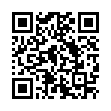
This file has been shared publicly by a user of PDF Archive.
Document ID: 0000490408.